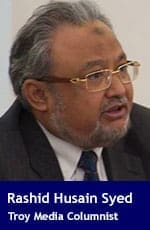 Saudi Arabia has capitulated. A few moves here and there, in Washington and elsewhere, made the trick work.
Saudi Arabia has capitulated. A few moves here and there, in Washington and elsewhere, made the trick work.
Saudi Arabia made a surprise announcement last week that it would cut its crude oil output by a further one million barrels per day (bpd) from planned June levels, “voluntarily.”
This takes the total Saudi production cuts from April to 4.8 million bpd, slashing its production to 7.5 million bpd, down almost 39 percent from its April output of 12 million bpd.
This is huge.
Taking the cue, the United Arab Emirates and Kuwait joined the Saudis, pledging additional cuts to their June crude oil output by a combined 180,000 bpd.
The voluntary cut is in sharp contrast to the Saudi position taken barely a couple of months ago. On March 6, it announced it was opening its taps to capacity, after Russia declined to cut its output further.
And world oil prices dipped into the negative territory.
What made Saudi Arabia take this sharp U-turn?
Certainly, economics and the desperate need to generate additional cash compelled the Saudis to make some bitter decisions and sharp reversals.
But there seem to be other reasons as well.
One can’t avoid connecting the dots here. Only the week before the Saudi decision to cut its output further, the United States announced it was pulling out its Patriot missile batteries, which guard Saudi oil facilities.
Associated Press quoted an American official who said disagreement over oil production led to the U.S. decision. The anonymous source also said the U.S. would pull out 300 troops staffing the missile batteries.
The missiles were flown into Saudi Arabia and installed at Prince Sultan airbase, outside Riyadh, in the immediate aftermath of the missile attack on Abqaiq and Khurais – two of the kingdom’s most crucial oil sites.
The Yemeni Houthi rebels claimed credit for the attack, yet both the United States and Saudi Arabia pointed fingers at Iran.
Just before the announcement of the missile removal, U.S. President Donald Trump said his administration was “doing some things” and “making a lot of moves in the Middle East and elsewhere. We’re doing a lot of things all over the world militarily. We’ve been taken advantage of all over the world, our military.”
“Saudi Arabia is a very wealthy country and they’ve agreed to help defray some of the costs, which nobody else would ever ask for,” the president said, adding that “if we’re going to defend countries, they should also respect us by making a contribution.”
There have also been hints that Washington was looking at easing restrictions on Iran, Saudi Arabia’s arch-foe. That too may have spurred the Saudis to lower crude output.
The focus isn’t just on Saudi Arabia. The United Arab Emirates is also under the hammer.
In late April, the world’s anti-money-laundering watchdog, the Financial Action Task Force (FATF) warned in a report that the U.A.E. must take increased measures to counter money laundering or risk inclusion on the FATF watch list. The report gave the U.A.E. a year to plug the loopholes in its financial system.
While Trump is endeavouring, in an election year, to bail out the U.S. shale energy sector and protect its hundreds of thousands of American jobs, pressure grew on the Saudis. Trump can’t afford to lose voter support in the country’s energy belt.
And with the political survival of Saudi Prince Mohammad Bin Salman dependent on support from Washington, the Saudis couldn’t afford to say no to further crude oil production cuts.
So they relented.
Toronto-based Rashid Husain Syed is a respected energy and political analyst. The Middle East is his area of focus. As well as writing for major local and global newspapers, Rashid is also a regular speaker at major international conferences. He has been asked to provide his perspective on global energy issues by both the Department of Energy in Washington and the International Energy Agency in Paris.
The views, opinions and positions expressed by columnists and contributors are the author’s alone. They do not inherently or expressly reflect the views, opinions and/or positions of our publication.


